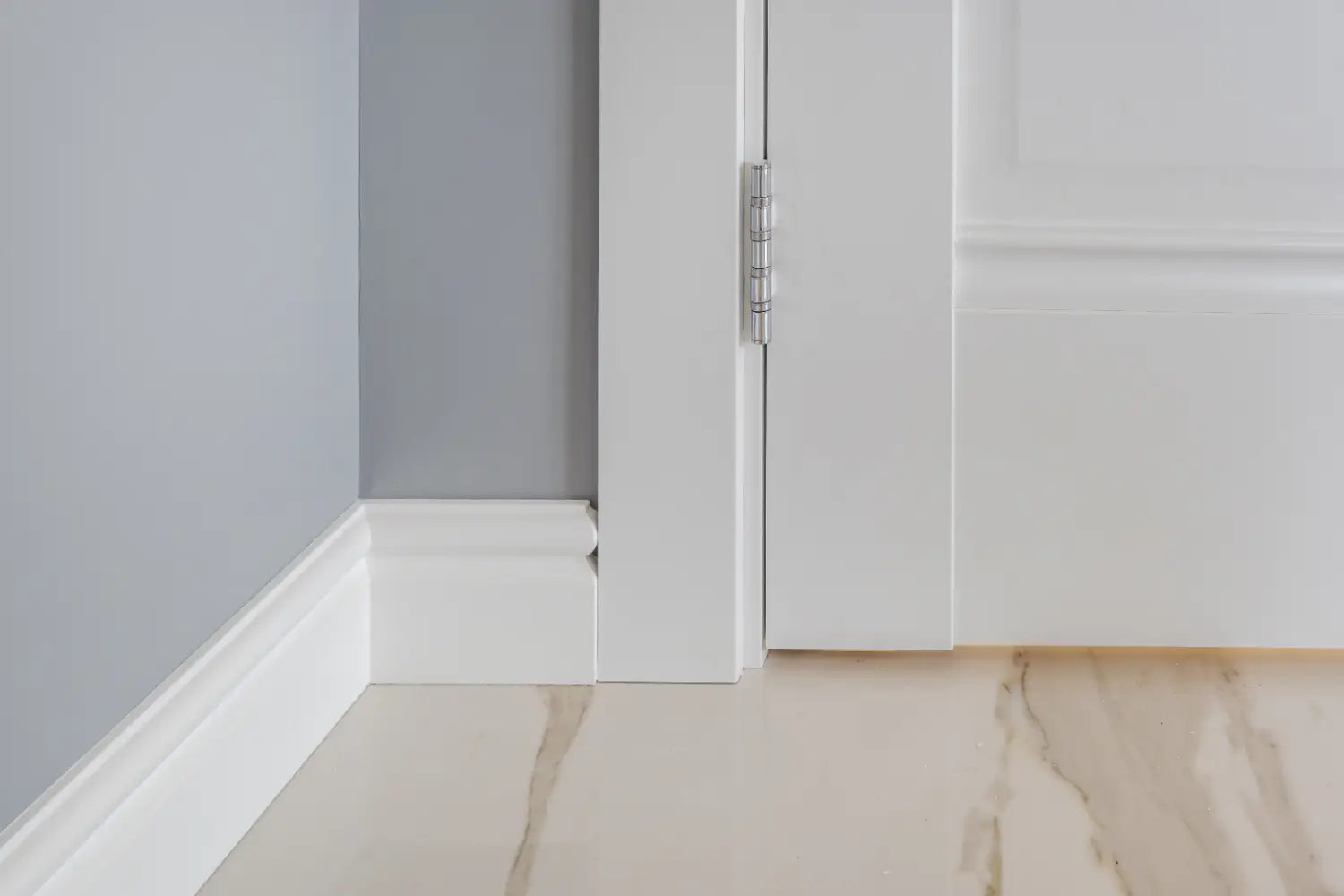
No Skirting Boards? This Is Why You Need Them!
Skirting boards are a key feature in interior design, yet some homeowners consider going without them for a more minimalistic look. However, skipping skirting boards can lead to practical issues, such as wall damage, visible gaps, and a lack of visual cohesion. So, are skirting boards necessary?
Skirting boards protect walls from scuffs, dents, and daily wear, while also concealing expansion gaps in flooring. They enhance room aesthetics, create a polished transition between walls and floors, and reduce maintenance efforts. Without them, interiors can appear unfinished, making skirting boards an essential design and functional feature.
In this guide, we’ll explore the functional and aesthetic benefits of skirting boards, how they protect walls and enhance interior design, what alternatives exist if you’re looking for a different approach, and expert recommendations on choosing the right skirting for your home.
What Happens If You Have No Skirting Boards?
While some modern interior trends lean towards a skirting-free look, removing them completely can create several challenges:
1. Increased Wall Damage
Without skirting boards, walls are more prone to scuffs, dents, and marks from daily activities. Vacuum cleaners, furniture, and foot traffic can easily damage unprotected plaster, leading to costly repairs over time. In high-traffic areas such as hallways, living rooms, and kitchens, this can become a major issue.
2. Poor Finish and Visible Gaps
Walls and floors rarely meet with a perfect join, leaving unsightly gaps and inconsistencies. This is especially noticeable with wooden, laminate, or tiled flooring, where expansion gaps are necessary to prevent warping. Skirting boards provide a seamless transition, covering up these imperfections and ensuring a polished look.
3. Dust and Dirt Collection
Without skirting, the base of walls can trap dust, dirt, and debris, making cleaning more difficult. The accumulation of dust in these areas can affect indoor air quality, particularly in homes with pets or carpeted flooring. Skirting boards create a barrier that reduces dust buildup, helping to keep interiors cleaner and healthier.
4. Lack of Visual Definition
Skirting boards help define the structure of a room, giving balance and proportion to the space. Without them, walls and floors can look unfinished or flat, especially in larger rooms. The absence of a skirting line can also make the transition between the wall and the floor appear abrupt, rather than smoothly integrated.
The Functional Benefits of Skirting Boards
1. Protecting Walls from Damage
Skirting boards act as a buffer between the wall and everyday wear and tear, reducing impact damage from furniture, shoes, and household cleaning tools. This is particularly important in homes with children, pets, or high foot traffic.
2. Hiding Floor Expansion Gaps
Wooden and laminate flooring expands and contracts with temperature changes and humidity levels. Skirting boards conceal these expansion gaps, preventing unsightly separations and potential flooring issues.
3. Enhancing Durability
Plaster walls are fragile and easily chipped at the base. Skirting boards add an extra layer of protection, increasing the durability of your walls and keeping your home looking its best. Over time, they reduce maintenance costs by minimising the need for frequent wall repainting or plaster repairs.
4. Reducing Maintenance and Cleaning
By covering the lower portion of the wall, skirting boards prevent dirt accumulation and make it easier to clean floors without worrying about damaging the plaster. They also provide a defined edge that makes vacuuming and mopping simpler, preventing dust and debris from settling in corners.
The Aesthetic Role of Skirting Boards
1. Framing the Room
Skirting boards create a visual transition between the floor and walls, adding a finishing touch that makes the space feel complete and well-defined. In both traditional and modern interiors, skirting provides a subtle or statement design feature that enhances the room’s overall look.
2. Matching Interior Styles
Available in traditional and contemporary styles, skirting boards complement a wide range of architectural themes, from Victorian-period homes to sleek modern interiors. Whether you're looking for intricate detailing or a minimalist aesthetic, there’s a skirting board style to suit your space.
3. Creating a Cohesive Look
When combined with architraves, dado rails, and wall panelling, skirting boards contribute to a unified and elegant interior scheme. Matching these mouldings creates consistency throughout the home, making rooms feel more polished and thoughtfully designed.
4. Enhancing Room Proportions
-
Taller skirting boards add grandeur to high-ceilinged rooms, helping to maintain proportion.
-
Lower skirting boards provide a minimalist, contemporary feel in modern spaces, particularly in open-plan layouts.
-
Contrasting colours create a bold, eye-catching design feature, while seamless colour matching provides a subtle, sophisticated appearance.
Modern vs Traditional Skirting Board Styles
1. Period Homes & Classic Interiors
-
Victorian & Edwardian Skirting – Deep, detailed profiles with ornate designs that add historical charm.
-
Georgian Skirting – Symmetrical and proportionate, ideal for heritage properties where grandeur is key.
-
Art Deco Skirting – Bold, geometric patterns with a vintage aesthetic, suited to early 20th-century homes.
2. Contemporary & Minimalist Designs
-
Square-Edge Skirting – Clean, modern lines for a subtle, understated effect.
-
Flush Skirting – Embedded into the wall for a sleek, frameless look, often seen in minimalist architecture.
-
Shadow Gap Skirting – A recessed detail creates a floating wall effect, adding a high-end designer feel.
What If You Don’t Want Skirting Boards? Alternatives & Considerations
If you prefer a skirting-free aesthetic, there are alternative solutions, but each comes with its own challenges:
1. Integrated Wall Trims
Built-in trims provide a subtle, minimalistic alternative, but they require precision installation and don’t offer the same durability as traditional skirting.
2. Floor-to-Wall Sealants
Silicone or rubber sealing strips can close gaps, but they lack visual appeal and won’t protect against impact damage.
3. Metal or PVC Edge Protectors
Common in commercial buildings, these options are durable but not always visually appealing for residential spaces.
4. Floating Walls & Shadow Gaps
A high-end modern solution that creates a clean, contemporary aesthetic, but requires expert installation and additional wall reinforcement.
Choosing the Right Skirting Boards for Your Home
1. Material Selection
-
Solid Wood – Traditional and durable, ideal for period homes.
-
MDF Skirting – Affordable, smooth, and easy to paint.
-
PVC & Composite Skirting – Moisture-resistant, perfect for kitchens and bathrooms.
2. Height & Profile
-
Taller skirting boards work well in large rooms with high ceilings.
-
Slimline skirting is better suited to modern, minimalist spaces.
-
Decorative profiles add character to classic interiors.
3. Colour & Finish
-
White or neutral tones for a timeless look.
-
Natural wood stain for a warm, classic aesthetic.
-
Contrasting colours for bold, statement designs.
Conclusion
While some modern interiors experiment with no skirting boards, the benefits of skirting far outweigh the downsides. They protect walls, enhance interior design, and create a polished finish, making them a key element of any well-designed home.
For high-quality skirting boards, architraves, and interior mouldings, explore MR Mouldings. With a range of traditional and modern designs, you can find the perfect solution to elevate your space.



